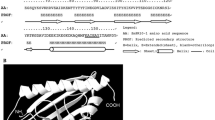Abstract
A ribonuclease from a callus cell culture of Panax ginseng C.A. Mey strain R1 was isolated. A pure protein with an apparent molecular mass of 18 kDa was obtained. The N-terminal sequences of the protein and of the C-terminal CNBr peptide were determined. No homology with other ribonucleases was found, but there was 60–70% sequence identity with two intracellular pathogenesis-related (IPR) proteins from parsley, indicating that not only these two proteins, but also homologous IPR proteins identified in other plant species are ribonucleases.
Similar content being viewed by others
Abbreviations
- IPR:
-
intracellular pathogenesis-related
References
Beintema, J.J., Schüller, C., Irie, M., Carsana, A. (1988) Molecular evolution of the ribonuclease superfamily. Prog. Biophys. Mol. Biol. 51, 165–192
Bol, J.F., Linthorst, H.J.M., Cornelissen, B.J.C. (1990) Plant pathogenesis-related proteins induced by virus infection. Annu. Rev. Phytopath. 28, 113–138
Breiteneder, H., Pettenburger, K., Bito, A., Valenta, R., Kraft, D., Rumpold, H., Scheiner, O., Breitenbach, M. (1989) The gene coding for the major birch pollen allergen Betvl is highly homologous to a pea disease resistance response gene. EMBO J. 8, 1935–1938
Doolittle, R.F. (1981) Similar amino acid sequences: chance or common ancestry? Science 214, 149–159
Fristensky, B., Horovitz, D., Hadwiger, L.A. (1988) cDNA sequences for pea disease resistance response genes. Plant Mol. Biol. 11, 713–715
Hamann, K.J., Barker, R.L., Loegering, D.A., Pease, L.R., Gleich, G.J. (1989) Sequence of human eosinophil-derived neurotoxin cDNA: identity of deduced amino acid sequence with human nonsecretory ribonucleases. Gene 83, 161–167
Horiuchi, H., Yanai, K., Takagi, M., Yano, K., Wakabayashi, E., Sanda, A., Mine, S., Ohgi, K., Irie, M. (1988) Primary structure of a base non-specific ribonuclease from Rhizopus niveus. J. Biochem. (Tokyo) 103, 408–418
Jost, W., Bak, H., Glund, K., Terp-stra, P., Beintema, J.J. (1991) Amino acid sequence of an extracellular, phosphate-starvation-induced ribonuclease from cultured tomato (Lycopersicon esculentum) cells. Eur. J. Biochem. 198, 1–6
Kamiya, Y., Oyama, F., Oyama, R., Sakakibara, F., Nitta, K., Kawauchi, H., Takayanagi, Y., Titani, K.J. (1990) Amino acid sequence of a lectin from Japanese frog (Rana japonica) eggs. J. Biochem. (Tokyo) 108, 139–143
Laemmli, U.K. (1970) Cleavage of structural proteins during the assembly of the head of bacteriophage T4. Nature (London) 227, 680–685
McClure, B.A., Haring, V., Ebert, P.R., Anderson, M.A., Simpson, R.J., Sakiyama, F., Clarke, A.E. (1989) Style self-incompatibility gene products of Nicotiana alata are ribonucleases. Nature (London) 342, 955–957
Matton, D.P., Brisson, N. (1989) Cloning, expression and sequence conservation of pathogenesis-related gene transcripts of potato. Mol. Plant-Microbe Interact. 2, 325–331
Murashige, T., Skoog, F. (1962) Revised medium for rapid growth and bioassays with tobacco tissue cultures. Physiol. Plant. 15, 473–479
Shapiro, R., Riordan, J.F., Vallee, B.L. (1986) Characteristic ribonucleolytic activity of human angiogenin. Biochemistry 25, 3527–3532
Somssich, I.E., Schmelzer, E., Kawalleck, P., Hahlbrock, K. (1988) Gene structure and in situ transcript localization of pathogenesis-related protein 1 in parsley. Mol. Gen Genet. 213, 93–98
Taylor, C.B., Bariola, P.A., DelCardayré, S.B., Raines, R.T., Green, P.J. (1993) RNS2: A senescence-associated RNase of Arabidopsis that diverged from the S-RNases before speciation. Proc. Natl. Acad. Sci. USA 90, 5118–5122
Van de Löcht, U., Meier, I., Hahlbrock, K., Somssich, I.E. (1990) A 125 bp promotor fragment is sufficient for strong elicitor-mediated gene activation in parsley. EMBO J. 9, 2945–2950
Van Loon, L.C. (1985) Pathogenesis-related proteins. Plant Mol. Biol. 4, 111–116
Walter, M.H., Liu, J.-W., Grand, C., Lamb, C.J., Hess, D. (1990) Bean pathogenesis-related (PR) proteins deduced from elicitor-induced transcripts are members of a ubiquitous new class of conserved PR proteins including pollen allergens. Mol. Gen. Genet. 222, 353–360
Warner, S.A.J., Scott, R., Draper, J. (1992) Characterisation of a wound-induced transcript from the monocot asparagus that shares similarity with a class of intracellular pathogenesis-related (PR) proteins. Plant Mol. Biol. 19, 555–561
Author information
Authors and Affiliations
Additional information
These studies have been made possible by grants from the Royal Netherlands Academy of Sciences (KNAW), Amsterdam, and The Netherlands Organization for Scientific Research (NWO), The Hague. We thank Dr. R.N. Campagne (Groningen, The Netherlands) for reviewing the manuscript.
Rights and permissions
About this article
Cite this article
Moiseyev, G.P., Beintema, J.J., Fedoreyeva, L.I. et al. High sequence similarity between a ribonuclease from ginseng calluses and fungus-elicited proteins from parsley indicates that intracellular pathogenesis-related proteins are ribonucleases. Planta 193, 470–472 (1994). https://doi.org/10.1007/BF00201828
Received:
Accepted:
Issue Date:
DOI: https://doi.org/10.1007/BF00201828




